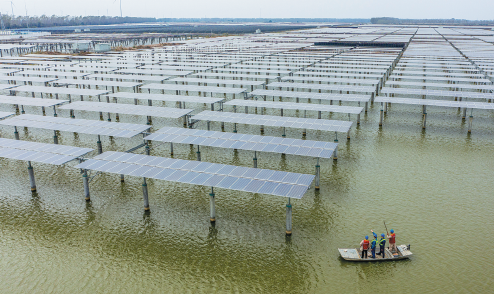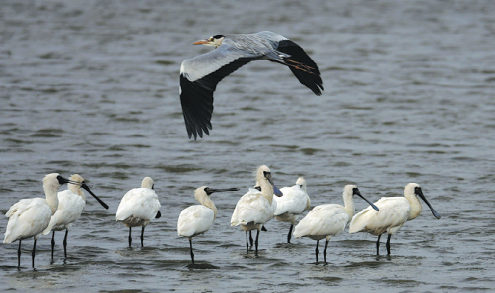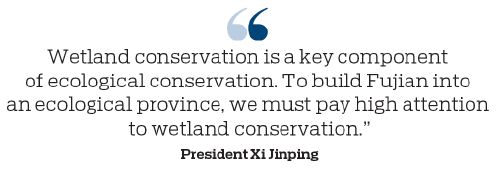TO GREENER DEVELOPMENT
China shows continual commitment to ecological conservation and clean energy
"Look at that black-faced spoonbill with a GPS receiver on its back. The device was put in by researchers in South Korea," said Wang Naizhu, a bird lover who happily took several photos of the spoon-billed sandpiper on Dec 7. The sandpiper is a critically endangered bird that traveled from as far as Siberia to the Minjiang River estuary in Fuzhou, capital of Fujian province.
"The Eurasian teals are also from Siberia," Wang added.
When winter comes, the wetland at the estuary is a haven for migratory birds. With binocles and telephoto lenses, people visit the nature reserve to watch the birds of passage. Bright colored clothes, drones and making loud noises are prohibited.
"At the midpoint of the East Asian-Australasian Flyway, the reserve is the only place where the Chinese crested tern, spoon-billed sandpiper and black-faced spoonbill-all rare birds-can be spotted," Wang said.
There are only 50 Chinese crested terns left in the world. The bird is one of the most critically endangered species in the world.
The EAAF is one of the nine largest flyways globally, extending from Alaska in the United States to Far East Russia in the North, and Australia and New Zealand in the South. It spans across 22 countries and regions. More specifically, it covers the "East Line" of flyways in China.
The conservation, which covers 2,382 hectares, has 1,089 kinds of wild animals and plants. More than 50,000 migratory birds stop off in the reserve every year.
Saltmarsh cordgrass, an invasive plant from foreign lands, once grew so rapidly at the Minjiang River estuary that the quality of the wetland was at stake. So in order to prevent the invasive cordgrass from growing further, the local government has been growing local plants such as mangroves and reeds since 2004. The estuary conservation plans to remove all of the invasive plant by this year. The reserve has set aside 34 hectares of barren beach land for water fowls to forage and inhabit. It has also turned 175 hectares of fish ponds in the conservation into resting places for the birds.
When President Xi Jinping served as governor of Fujian in 2002, he ordered a halt to a proposed wetland reclamation project at the estuary.
Fuzhou authorities then revoked a floodplain reclamation project with an area of about 66.67 hectares, which the city approved in 2001. It later built the Minjiang River Estuary National Nature Reserve.
"Wetland conservation is a key component of ecological conservation. To build Fujian into an ecological province, we must pay high attention to wetland conservation," Xi said.
With its impressive efforts to improve ecological conditions, Fujian along with Jiangxi and Guizhou provinces, were declared by the central government as role models for the rest of the country last year.
The three provinces were designated as pilot zones for ecological civilization in 2016.
Since taking office in 2012, President Xi has been stressing the progress of ecological preservation. In recent years, he has laid out numerous plans to promote green development, tackle pollution to ensure blue skies, and promote a revolution in clean energy in line with his idea of building a beautiful China by 2035.
Xi's ecological civilization theory reflects a profound shift in China's concept and model of development, and represents the Chinese people's expectations for a better life.
Last year, ecological civilization topped the agenda of the Chinese government, with Xi visiting the wetlands in Yunnan and Zhejiang provinces, and a nature reserve in Shaanxi province where he called local officials to be the ecological guardians of Qinling Mountains.
A natural boundary between China's north and south, the Qinling Mountains are home to a huge variety of plants and rare wildlife such as giant pandas, golden monkeys and crested ibis.
Climate commitment
China has taken a nature positive stance on greener, sustainable development. Delivering a speech via video at the 75th Session of the United Nations General Assembly in New York in September, Xi announced China's commitment to achieve peak carbon dioxide emissions before 2030 and to become carbon neutral before 2060. In doing so, it joins the European Union, the United Kingdom and Canada in adopting the climate targets set out in the Paris Agreement.
World leaders welcomed Xi's announcement, which is expected to be the single largest climate commitment to date, saying this gives a strong signal that China takes its responsibilities seriously.
When he addressed the Climate Ambition Summit 2020 in December, Xi announced that China would take additional steps to deliver its 2030 ambitions.
Specifically, China will lower its carbon dioxide emissions per unit of GDP by over 65 percent from the 2005 level, increase the share of non-fossil fuels in primary energy consumption to around 25 percent, increase forest stock volume by 6 billion cubic meters from the 2005 level, and bring its total installed capacity of wind and solar power to more than 1.2 billion kilowatts.
In a blog post, four experts from the Natural Resources Defense Council wrote that Xi's September announcement provided a much-needed boost to global efforts to tackle climate change in a year in which the pandemic has challenged the abilities of countries to work together to address important global challenges.
They wrote that Xi's new announcement is a step forward, and key near-term targets being decided in the coming months will require greater ambition in order to fully align with China's goal of achieving carbon neutrality before 2060.
The four experts-Jake Schmidt, Alvin Lin, Brendan Guy and Han Chen-said China has a major opportunity in the overall plan to demonstrate its commitment to accelerate away from coal and toward clean energy, and align with its vision of carbon neutrality.
He Jiankun, chairman of the Institute of Climate Change and Sustainable Development at Tsinghua University, said China's carbon emission commitment will give the new energy vehicle industry an opportunity to grow.
New energy
As the number of vehicles grows rapidly in the past two decades, automobiles are an increasingly big source of carbon dioxide emissions. Carbon emissions from China's auto industry will reach the peak in 2028, ahead of the national carbon emission reduction commitment. By 2035, the total carbon emissions will drop by more than 20 percent compared to its peak levels.
The Society of Automotive Engineers of China released an updated technology road map in November, and it clearly outlines the electricity driven development strategy.
According to the policy paper Technology Roadmap for Energy Saving and New Energy Vehicles 2.0, the annual sales of electric vehicles will account for more than 95 percent of all NEV sales in China by 2035.
The number of fuel cell car ownership will reach 1 million, while energy saving vehicles will be largely converted to hybrid vehicles, contributing to the transformation toward electrification of the entire auto industry.
Sales of electric, plug-in hybrid and hydrogen powered vehicles in China are forecast to rise to 20 percent of overall new car sales by 2025 from just 5 percent now.
China is now embarking on an accelerated clean energy transition as it bids to become carbon neutral by 2060, and construction is expected to hit new highs in coming years.
Tsinghua University's climate change and sustainable development institute published a government linked report in October, outlining a road map for the country's energy transition. The paper advised the Chinese government to follow policies for non-fossil fuels to reach 24.3 to 28.6 percent of China's primary energy mix by 2030, with the share of coal falling 43 to 46 percent from the current 57 percent.
China has brought about 40 gigawatts of new solar power into operation last year, taking its total installed solar capacity to 240 GW, according to the country's solar manufacturing association.
Wang Bohua, vice-chairman of the China Photovoltaic Industry Association, believed that China's solar capacity growth was expected to reach an average of 70 GW a year during the 14th Five-Year Plan period (2021-25), and could even be as high as 90 GW.
A UK based HSBC Bank report said increased solar generation capacity will further drive the cost of solar power down, by as much as 50 percent from current levels by 2025.
Li Zhenguo, founder of Longi Green Energy Technology, expected that electricity costs from solar PV would fall 60 to 70 percent in the next three decades.
Zhao Taiping, director of the new energy department at the China Renewable Energy Engineering Institute, proposed that China should quickly develop its non-fossil energy in the next five years.
Zhao said the country has bright prospects for renewable energy, which will account for some 75 percent of energy consumed by 2060.
Lin Boqiang, president of the Energy Policy Institute at Xiamen University, said China's energy supply will combine renewables and energy in storage. Such a system will effectively reduce carbon emissions and ensure a safe, stable power supply.
China is the largest manufacturer and installer of solar photovoltaic power systems in the world, and the outline of its 14th Five-Year Plan for energy shows the country could increase annual installations of solar power generation capacity to as much as 85 GW-about double the country's current rate.
caihong@chinadaily.com.cn

















